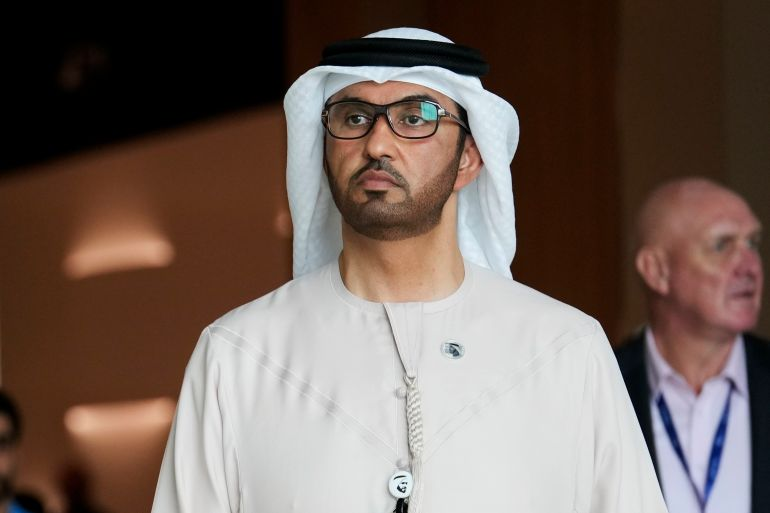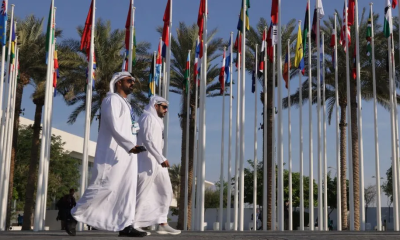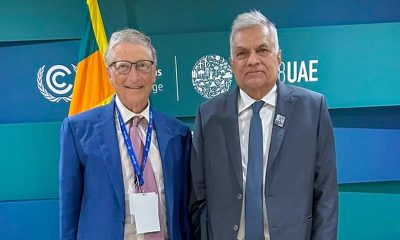Foreign News
COP28 president denies UAE using UN climate talks to seek oil deals

The Emirati president of the United Nations Climate conference in Dubai has denied reports that he has used his role at the negotiations to pursue fossil fuel deals.
A day before the talks are due to begin, Sultan al-Jaber, who also is the CEO of the state-run Abu Dhabi National Oil Co (Adnoc), rejected allegations made in a joint investigation by the Centre for Climate Reporting (CCR) and the BBC.
“These allegations are false, not true, incorrect and not accurate,” Jaber told reporters on Wednesday ahead of the talks, which will draw world leaders and tens of thousands of delegates to Dubai over the next two weeks.
“It’s an attempt to undermine the work of the COP28 presidency. Let me ask you a question: Do you think the UAE or myself will need the COP or the COP presidency to go and establish business deals or commercial relationships?”
Leaked documents show that al-Jaber planned to discuss fossil fuel deals in bilateral meetings at the climate summit, the CCR said.
According to the non-profit investigative journalism group, the documents include more than 150 pages of briefings prepared by COP28 staff from July to October and obtained by the CCR and the BBC from an anonymous whistle-blower. The documents indicate Jaber planned to discuss commercial interests with almost 30 countries, according to CCR.
The briefing notes, detailed in reports published on Monday, signalled Adnoc’s willingness to work with countries including China, Germany and Egypt to develop oil and gas projects.
Former United States Vice President Al Gore, who won the Nobel Peace Prize for campaigning for climate action, said the allegations “have confirmed some of the worst fears” around al-Jaber while former UN climate chief Christiana Figueres said the COP28 host had been caught “red-handed”.
“The global community’s gaze is fixed upon these leaders, expecting them to embody the very essence of integrity, untainted by bias and national or personal gain,” said Tasneem Essop, executive director of Climate Action Network International. “Any deviation from this path represents a betrayal of the trust placed in them by the world and a failure in their duty to future generations,” she wrote on X.
Al-Jaber, a 50-year-old longtime climate envoy, is a trusted confidant of the leader of the United Arab Emirates, Mohammed bin Zayed Al Nahyan. He’s been behind tens of billions of dollars spent or pledged towards renewable energy in the UAE.
He has weathered other controversies over alleged conflict of interest since being appointed COP28 president this year, including calls from US and European lawmakers for his replacement.
Supporters, including US climate envoy John Kerry, said al-Jaber is uniquely positioned to broker compromise at the COP28 talks, where world leaders will be confronted by their lack of progress in curbing global warming in a record-breaking hot year.
Reining in the use of fossil fuels and carbon emissions are expected to top the agenda of the 13-day summit, which runs from Thursday until December 12. International funding to help countries adapt to climate change will also be hotly debated as developing countries have been demanding more contributions from industrialised nations.
An ambitious loss and damages fund agreed last year to support poorer nations to help manage the negative effects of climate change is also going to be one of the main issues covered in the negotiations. World leaders agreed to the fund at COP27 last year, but they have failed to reach consensus on the most important questions of all – which states will pay into it and how much
The CCR said that alongside the briefings, it has also seen emails and meeting records “which raise serious questions about the COP28 team’s independence from Adnoc”.
“Please, for once, respect who we are, respect what we have achieved over the years and respect the fact that we have been clear, open and clean and honest and transparent on how we want to conduct this COP process,” al-Jaber said.
(Aljazeera)
Foreign News
Nasa ‘Earthrise’ astronaut dies at 90 in plane crash

Apollo 8 astronaut Bill Anders, who snapped one of the most famous photographs taken in outer space, has died at the age of 90.
Officials say a small plane he was flying crashed into the water north of Seattle, Washington.
Anders’ son Greg confirmed that his father was flying the small plane, and that his body was recovered on Friday afternoon. “The family is devastated. He was a great pilot. He will be missed,” a statement from the family reads.
Anders – who was a lunar module pilot on the Apollo 8 mission – took the iconic Earthrise photograph, one of the most memorable and inspirational images of Earth from space.
Taken on Christmas Eve during the 1968 mission, the first crewed space flight to leave Earth and reach the Moon, the picture shows the planet rising above the horizon from the barren lunar surface.
Anders later described it as his most significant contribution to the space programme.

The image is widely credited with motivating the global environmental movement and leading to the creation of Earth Day, an annual event to promote activism and awareness of caring for the planet.
Speaking of the moment, Anders said: “We came all this way to explore the Moon, and the most important thing that we discovered was the Earth.”
Officials said on Friday that Anders crashed his plane around 11:40PDT (1940BST).
The US National Transportation Safety Board (NTSB) said the 90-year-old was flying a Beechcraft A A 45 – also known as a T-34. The agency said that the plane crashed about 80ft (25m) from the coast of Jones Island.
Anders also served as the backup pilot to the Apollo 11 mission, the name of the effort that led to the first Moon landing on July 24, 1969.
Following Anders’ retirement from the space programme in 1969, the former astronaut largely worked in the aerospace industry for several decades. He also served as US Ambassador to Norway for a year in the 1970s.
But he is best remembered for the Apollo 8 mission and the iconic photograph he took from space.
“In 1968, during Apollo 8, Bill Anders offered to humanity among the deepest of gifts an astronaut can give. He traveled to the threshold of the Moon and helped all of us see something else: ourselves,” Nasa Administrator Bill Nelson said in a statement.
Mark Kelly, a former astronaut who now serves as a US Senator for the state of Arizona, said in a post on X, formerly Twitter, that Anders “inspired me and generations of astronauts and explorers. My thoughts are with his family and friends”.
[BBC]
Foreign News
China’s Chang’e-6 lifts off from far side of Moon with rock samples

A Chinese spacecraft carrying rock and soil samples from the far side of the Moon has lifted off from the lunar surface to start its journey back to Earth, according to state media.
The achievement on Tuesday is a world first and the latest leap for Beijing’s decades-old space programme, which aims to send a crewed mission to the Moon by 2030.
The Xinhua News Agency, citing the China National Space Administration (CNSA), said that the ascender of the Chang’e-6 probe took off at 7:38am local time on Tuesday (23:38 GMT) and entered a preset orbit around the moon.
It described the move as “an unprecedented feat in human lunar exploration history”.
The Chang’e-6 probe was launched last month and its lander touched down on the far side of the Moon on Sunday. It used a drill and robotic arm to dig up soil on and below the Moon’s surface, according to Xinhua.
After successfully gathering its samples, the Chang’e-6 unfurled China’s national flag for the first time on the far side of the Moon, it said.
The agency cited the CNSA as saying that the spacecraft stowed the samples it had gathered in a container inside the ascender of the probe as planned.
[Aljazeera]
Foreign News
China says its spacecraft lands on Moon’s far side

China says its uncrewed craft has successfully landed on the far side of the Moon – an unexplored place almost no-one tries to go.
The Chang’e 6 touched down in the South Pole-Aitken Basin at 06:23 Beijing time on Sunday morning (22:23 GMT Saturday), the China National Space Administration (CNSA) said.
Launched on 3 May, the mission aims to collect precious rock and soil from this region for the first time in history. The probe could extract some of the Moon’s oldest rocks from a huge crater on its South Pole.
The landing was fraught with risks, because it is very difficult to communicate with spacecraft once they reach the far side of the Moon. China is the only country to have achieved the feat before, landing its Chang’e-4 in 2019.
After launching from Wenchang Space Launch Center, the Chang’e 6 spacecraft had been orbiting the Moon waiting to land. The lander component of the mission then separated from the orbiter to touch down on the side of the Moon that faces permanently away from Earth.
During the descent, an autonomous visual obstacle avoidance system was used to automatically detect obstacles, with a visible light camera selecting a comparatively safe landing area based on the brightness and darkness of the lunar surface, the CNSA was quoted as saying by state-run Xinhua news agency.
The lander hovered about 100m (328ft) above the safe landing area, and used a laser 3D scanner before a slow vertical descent. The operation was supported by the Queqiao-2 relay satellite, the CNSA said.
Chinese state media described the successful landing as an “historic moment”. The state broadcaster said “applause erupted at the Beijing Aerospace Flight Control Center” when the Chang’e landing craft touched down on the Moon early on Sunday morning.
The lander should spend up to three days gathering materials from the surface in an operation the CNSA said would involve “many engineering innovations, high risks and great difficulty”. “Everyone is very excited that we might get a look at these rocks no-one has ever seen before,” explains Professor John Pernet-Fisher, who specialises in lunar geology at the University of Manchester.
He has analysed other lunar rock brought back on the American Apollo mission and previous Chinese missions. But he says the chance to analyse rock from a completely different area of the Moon could answer fundamental questions about how planets form.
Most of the rocks collected so far are volcanic, similar to what we might find in Iceland or Hawaii. But the material on the far side would have a different chemistry . “It would help us answer those really big questions, like how are planets formed, why do crusts form, what is the origin of water in the solar system?” the professor says.
The mission aims to collect about 2kg (4.4lb) of material using a drill and mechanical arm, according to the CNSA.
The South Pole–Aitken basin, an impact crater, is one of the largest known in the solar system.
From there, the probe could gather material that came from deep inside the lunar mantle – the inner core of the Moon – Prof Pernet-Fisher says.
The Moon’s South Pole is the next frontier in lunar missions – countries are keen to understand the region because there is a good chance it has ice.

The capsule in the last Chinese moon mission, Chang’e 5, brought back soil and rocks in 2020 (BBC)
Access to water would significantly boost the chances of successfully establishing a human base on the Moon for scientific research.
If the mission succeeds, the craft will return to Earth with the precious samples on board a special return capsule.
The material will be kept in special conditions to try to keep it as pristine as possible.
Scientists in China will be given the first chance to analyse the rocks, and later researchers around the world will be able to apply for the opportunity too.
This is the second time China has launched a mission to collect samples from the Moon.
In 2020 Chang’e 5 brought back 1.7kg of material from an area called Oceanus Procellarum on the Moon’s near side.
China is planning three more uncrewed missions this decade as it looks for water on the Moon and investigates setting up a permanent base there.
Beijing’s broader strategy aims to see a Chinese astronaut walk on the moon by around 2030.
The US also aims to put astronauts back on the moon, with Nasa aiming to launch its Artemis 3 mission in 2026.
(BBC)
























